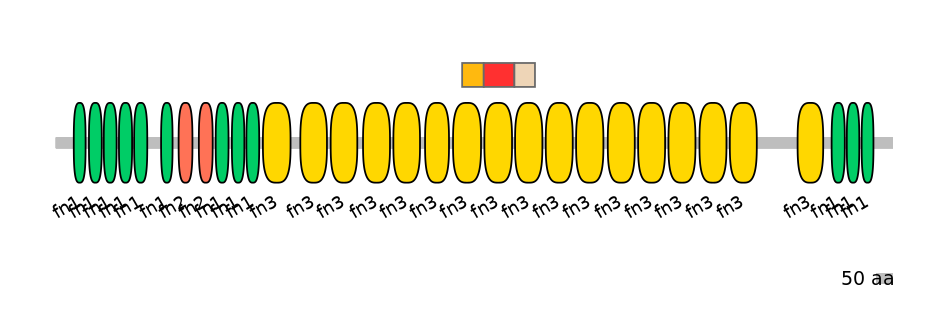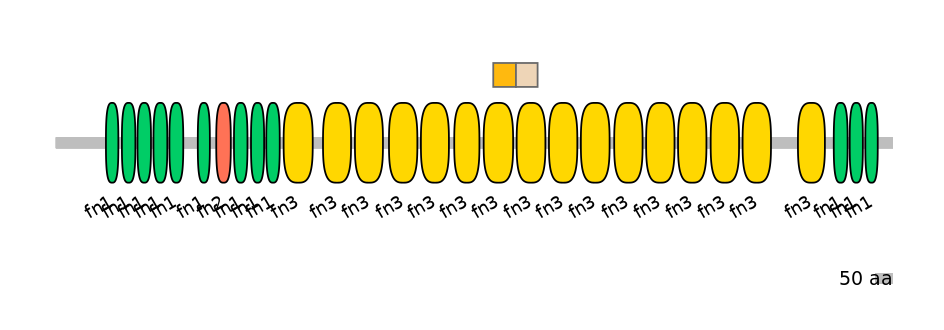GgaEX0004689 @ galGal3
Exon Skipping
Gene
ENSGALG00000003578 | FN1
Description
NA
Coordinates
chr7:4379690-4382491:-
Coord C1 exon
chr7:4382300-4382491
Coord A exon
chr7:4380914-4381186
Coord C2 exon
chr7:4379690-4379872
Length
273 bp
Sequences
Splice sites
3' ss Seq
TTTGCTCTTTAACTCATTAGAGG
3' ss Score
3.91
5' ss Seq
CGGGTGAAT
5' ss Score
3.31
Exon sequences
Seq C1 exon
GCATCAGTGGCTACCGAGTGACCACTGCTCCTACAAATGGACAGCAGGGTTCTACCTTGGAGGAAGTAGTAGGTGCAGATCAGACCTCTTGCACCTTTGAAAACCTAAACCCTGGTGTGGAGTACAATGTCAGTGTTTACGCAGTCAAAGATGACCAGGAGAGCATCCCCATCTCCAAAACCATCACGCAAG
Seq A exon
AGGTGCCCCAACTCACTGACCTAAGCTTTGTTGACATAACTGACTCAAGCATCGGCCTGAGGTGGACCCCGTTAAATGCCTCCACCATTATTGGGTACCGCATCACAGTAGTTGCGGCAGGAGAAAGTGTCCCTATTTTTGAAGATTTTGTGGACTCCTCAGTAGGATACTACACAGTGACAGGCTTGGAGCCGGGCATTGATTACGACATCAGTGTAATCACACTCATTAATGGCGGAGAGAGCGCCCCTACCACTCTGACACAGCAAACGG
Seq C2 exon
CCGTGCCTCCTCCCACTGATCTCCGCTTCACTAATGTGGGGCCTGATACCATGAGAGTGACATGGACTGCACCGACTTCCATCGTGCTGAGCAGTTTCTTGGTGCGCTACTCACCTGTGAAGAAGGAGGAGGACGTTGCAGAGCTGACAATTTCACCCTCAGACAACGTGGTGGTCTTAACAA
VastDB Features
Vast-tools module Information
Secondary ID
ENSGALG00000003578-'23-25,'23-24,24-25
Average complexity
S
Mappability confidence:
100%=100=100%
Protein Impact
Alternative protein isoforms (Ref)
No structure available
Features
Disorder rate (Iupred):
C1=0.392 A=0.087 C2=0.194
Domain overlap (PFAM):
C1:
PF0004116=fn3=PD(66.7=86.2)
A:
PF0004116=fn3=WD(100=90.2)
C2:
PF0004116=fn3=PU(72.0=95.2)

Main Skipping Isoform:
NA

Other Skipping Isoforms:
NA
Associated events
Other assemblies
Conservation
Fruitfly
(dm6)
No conservation detected
Primers PCR
Suggestions for RT-PCR validation
F:
GCAGGGTTCTACCTTGGAGGA
R:
ATTGTCAGCTCTGCAACGTCC
Band lengths:
300-573
Functional annotations
There are 10 annotated functions for this event
PMID: 21148425
[Disease association]. Thoracic aortic aneurysm is a common complication in patients with bicuspid aortic valve (BAV). Alternatively spliced extra domain A (EDA) (HsaEX0026101) of fibronectin (FN) has an essential role in tissue repair. This study analyzes the expression of FN spliceforms in dilated and nondilated ascending aorta of tricuspid aortic valve (TAV) and BAV patients. The mRNA expression was analyzed in the ascending aorta by Affymetrix Exon arrays in patients with TAV (n=40) and BAV (n=69). EDA and extra domain B (EDB) (HsaEX0026102) expression was increased in dilated aorta from TAV patients compared with nondilated aorta (P
PMID: 26106154
[Regulation only]. This study used both biochemical and physical tools coupled with engineered models, patient samples, and a murine model to investigate the role of the mechanical properties of the tumor microenvironment in regulating the production of the extra domain-B (EDB) (HsaEX0026102) splice variant of fibronectin (FN), a hallmark of tumor angiogenesis. Specifically, it showed that the amount of EDB-FN produced by endothelial cells increases with matrix stiffness both in vitro and within mouse mammary tumors. Matrix stiffness regulates splicing through the activation of serine/arginine rich (SR) proteins, the splicing factors involved in the production of FN isoforms. Activation of the SR proteins by matrix stiffness and the subsequent production of EDB-FN are dependent on intracellular contractility and PI3K-AKT signaling. Notably, matrix stiffness-mediated splicing is not limited to EDB-FN, but also affects splicing in the production of PKC betaII and the VEGF 165b splice variant. Together, these results demonstrate that the mechanical properties of the microenvironment regulate alternative splicing and establish a previously unidentified mechanism by which cells can adapt to their microenvironment.
PMID: 7806580
The study examined the cell-specific expression of two fibronectin isoforms, EIIIA (contains MmuEX0019422) and EIIIB (contains MmuEX0019423), during experimental hepatic fibrosis induced by ligation of the biliary duct. AT the mRNA level, EIIIA and EIIIB were undetectable in normal liver but expressed early injury, preceding fibrosis. The cellular sources of these changes were determined by fractionating the liver at various time points after bile duct ligation into its constituent cell populations and extracting RNA from the fresh isolates. EIIIA-containing fibronectin mRNA was undetectable in normal sinusoidal endothelial cells but increased rapidly within 12 h of injury. By contrast, the EIIIB form was restricted to hepatic lipocytes (Ito or fat-storing cells) and appeared only after a lag of 12-24 h: it was minimal in sinusoidal endothelial cells. Both forms were minimal in hepatocytes. At the protein level, EIIIA-containing fibronectin was markedly increased within two days of injury and exhibited a sinusoidal distribution. Secretion of this form by endothelial cells was confirmed in primary culture. Matrices deposited in situ by endothelial cells from injured liver accelerated the conversion (activation) of normal lipocytes to myofibroblast-like cells, and pretreatment of matrices with monoclonal antibody to the EIIIA segment blocked this response. Finally, recombinant fibronectin peptide containing the EIIIA segment was stimulatory to lipocytes in culture.
PMID: 12359774
Fibronectin 1 (FN) with extra domain B (EDB) (encoded by MmuEX0019423) is prominently expressed during embryonic development and in tumor tissues, although it is mostly eliminated from FN in normal adult tissues. To examine the function of the EDB segment in vivo, a mice lacking the EDB exon was generated using the Cre-loxP system. Although EDB-containing FNs are highly expressed throughout early embryogenesis, EDB-deficient mice developed normally and were fertile. Despite the absence of any significant phenotypes observed in vivo, however, fibroblasts obtained from EDB-deficient mice grew slowly in vitro and deposited less FN in the pericellular matrix than fibroblasts from wild-type mice.
PMID: 15367684
[Negative results]. Fibronectin 1 (FN) splice variants containing the EIIIA (MmuEX0019422) and/or EIIIB (MmuEX0019423) exons are prominently expressed in the vasculature of a variety of human tumors but not in normal adult tissues. To understand the functions of these splice variants in physiological and tumor angiogenesis, thus study used EIIIB-null and EIIIA-null strains of mice to examine neovascularization of mouse retinas, pancreatic tumors in Rip-Tag transgenic mice, and transplanted melanomas. Contrary to expectations, physiological and tumor angiogenesis was not significantly affected by the absence of either EIIIA or EIIIB splice variants. Tumor growth was also not affected. In addition, the expression levels of smooth muscle alpha actin, believed to be modulated by EIIIA-containing fibronectins, were not affected either.
PMID: 15610531
The fibronectins (FN) comprise a family of adhesive extracellular matrix proteins thought to mediate important functions in cutaneous wounds. Plasma fibronectin (pFN) extravasates for days from intact hyperpermeable vessels following injury whereas mRNAs encoding the cellular fibronectins (cFN) that include two segments, termed EIIIA (EDA) (MmuEX0019422) and EIIIB (EDB) (MmuEX0019423), are expressed by wound cells. Wounds in mice null for pFN appear to heal normally whereas those in EIIIA null mice exhibit defects, suggesting that cFN may play a role when pFN is missing. Integrin alpha9beta1, a receptor for several extracellular matrix proteins as well as the EIIIA segment, is expressed normally in the basal layer of squamous epithelia. The study reports results from immunohistochemistry on healing wounds demonstrating that EIIIA-containing cFN are deposited abundantly but transiently from day 4 to 7 whereas EIIIB-containing cFN persist at least through day 14. Elevated expression of alpha9beta1 is seen in basal and suprabasal epidermal keratinocytes in wounds. The spatial expression patterns of cFN and alpha9beta1 are distinct, but overlap in the dermal-epidermal junction, and both are expressed contemporaneously. These observations suggest a role for alpha9beta1-EIIIA interactions in wound keratinocyte function.
PMID: 17706958
Alternatively spliced variants of fibronectin (FN) containing exons EIIIA (MmuEX0019422) and EIIIB (MmuEX0019423) are expressed around newly forming vessels in development and disease but are downregulated in mature vasculature. The sequences and patterns of expression of these splice variants are highly conserved among vertebrates, suggestive of their biological importance; however the functions of EIIIA and EIIIB-containing FNs are unknown. To understand the role(s) of these splice variants, the authors deleted both EIIIA and EIIIB exons from the FN gene and observed embryonic lethality with incomplete penetrance by embryonic day 10.5. Deletion of both EIIIA and EIIIB exons did not affect synthesis or cell surface deposition of FN, indicating that embryonic lethality was due specifically to the absence of EIIIA and EIIIB exons from FN. EIIIA/EIIIB double-null embryos displayed multiple embryonic cardiovascular defects, including vascular hemorrhage, failure of remodeling embryonic and yolk sac vasculature, defective placental angiogenesis and heart defects. In addition, they observed defects in coverage and association with dorsal aortae of alpha-smooth-muscle-actin-positive cells. These studies indicate that the presence or absence of EIIIA and EIIIB exons alters the function of FN and demonstrate the requirement for these alternatively spliced exons in cardiovascular development.
PMID: 26637426
Using transgenic mouse models, the authors established that immune cell production of fibronectin contributes to phagocytosis, more so than circulating plasma fibronectin, and that accentuated release of EDB-containing (HsaEX0026102) fibronectin by immune cells improved phagocytosis. In line with this, administration of EDB fibronectin enhanced in vitro phagocytosis to a larger extent than plasma fibronectin. This enhancement was mediated by alphavbeta3 integrin as shown using inhibitors or cells from beta3 integrin knockout mice.
PMID: 28325836
Fibronectin is a multidomain protein secreted by various cell types. It forms a network of fibers within the extracellular matrix and impacts intracellular processes by binding to various molecules, primarily integrin receptors on the cells. Both the presence of several isoforms and the ability of the various domains and isoforms to bind to a variety of integrins result in a wide range of effects. In vivo findings suggest that fibronectin isoforms produced by the osteoblasts enhance their differentiation. Here the authors report that the isoform characterized by the presence of extradomain A (encoded by HsaEX0026101) activates alpha4beta1 integrin and augments osteoblast differentiation. In addition, the isoform containing extradomain B (encoded by HsaEX0026102) enhances the binding of fibronectin through the RGD sequence to beta3-containing integrin, resulting in increased mineralization by and differentiation of osteoblasts. These study thus reveals novel functions for two fibronectin isoforms and the mediating receptors in osteoblast differentiation.
PMID: 33207933
The authors perform quantitative proteomic analysis of the matrisome of murine carotid arteries in mice deficient in the production of FN splice isoforms containing alternative exons EIIIA and EIIIB (FN-EIIIAB null) after exposure to low and disturbed flow in vivo. They also examine serum-derived and endothelial-cell contributions to the matrisome in a simplified in vitro system. Flow-induced differences in the carotid artery matrisome that were impaired in FN-EIIIAB null mice. One of the most interesting differences was reduced recruitment of FBLN1 (fibulin-1), abundant in blood and not locally produced in the intima. This defect was validated in these in vitro assay, where FBLN1 recruitment from serum was impaired by the absence of these alternatively spliced segments.
GENOMIC CONTEXT[edit]
INCLUSION PATTERN[edit]